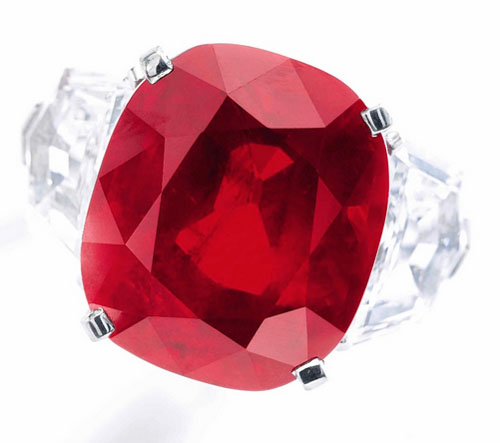Ruby

“This gem stone is a symbol of excellent health, vigor, love and passion. On wearing it renders a bold and courageous persona to the person.”
Rubies range in color from pinkish to orangey and purplish and brownish red, depending on the chromium and iron content of the stone. The most desirable color is the so-called “pigeon’s blood”, a pure red with a hint of blue.
Color is the most important consideration, with clarity a distant second. Large rubies are rare. The most desirable color is the so-called “pigeon’s blood”, a pure red with a hint of blue. Color saturation makes all the difference. Ruby shows pleochroism which means that the color varies with the direction of viewing. Stones displaying the cat’s eye or star affect effect are best viewed in daylight.
Many rubies will fluoresce in long or short wave UV and this property can often be used to help identify a stone’s geographic origin. Burmese rubies often fluoresce so strongly that the effect is noticeable even in sunlight; such stones seem literally to glow. Thai rubies generally lack this property.
Inclusions are common in ruby and not always an indication of lower quality. Included rutile needles cause the “silky shine”. If such a stone is cut en cabochon it exposes the rare cat’s eye effect. Oriented rutile crystal inclusions cause a six-rayed-star light effect (called asterism) to form the popular star ruby. Transparent rubies are cut in step and brilliant cut. Less transparent rubies are cut en cabochon.
Ruby location and deposits:
Myanmar: For centuries the most important deposits are in upper Myanmar (Burma) near Mogok. Only one percent of the production is of gem quality. Some of the rubies are of pigeon’s blood color and considered to be the most valuable rubies of all. In the early 1990’s large new deposits were discovered at Mong Hsu.
Thailand: Rubies found in Thailand (Chanthaburi district) often have a brown or violet tint. The Thai ruby production is declining, and Chanthaburi is now mainly a center for processing and trading gems.
Sri Lanka: The deposits are located in the southwest of the island in the Ratnapura district. Rubies from that deposit are usually light red to raspberry red.
Madagascar: in the 1990’s major ruby deposits were discovered in this huge island off the coast of Mozambique. Madagascar is now one of the world’s leading ruby producers.
Tanzania: On the upper Umba River in northwest Tanzania are deposits for gemstone quality rubies that are violet to brown-red. A few opaque rubies are mined as well.
Other deposits of some importance are found in: Afghanistan, Cambodia, Kenya and Vietnam. Less significant deposits are in: Australia, Brazil, India, Malawi, Nepal, Pakistan, United States and Zimbabwe.
Common Ruby treatments
The most common treatment for ruby is heat treatment. Stones, generally before they are cut, are heated to between 1700 to 1800 degrees Celsius (3100-3300 degrees F) for several hours. Heating often improves both color and clarity. A reputable dealer will always disclose gem treatments. Lower grade rubies with surface-reaching fissures are often fracture-filled with lead glass. This treatment produces good looking stones that can be sold at a very reasonable price.
Questions about Ruby or other aspects of Gemstone? Ask an expert of Moti Kashi Diamonds for answer. Our experts will answer any questions you have, and if you like, search for Ruby on your behalf that match your criteria.
